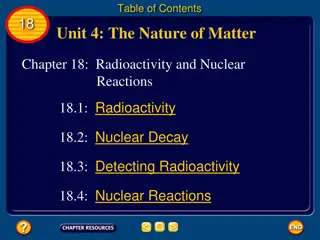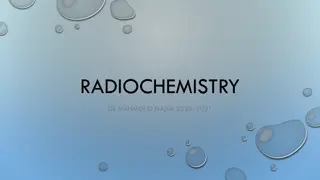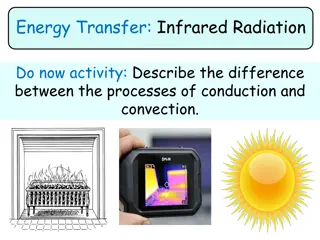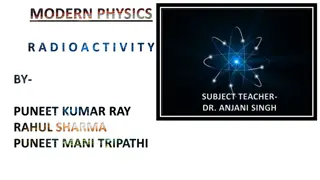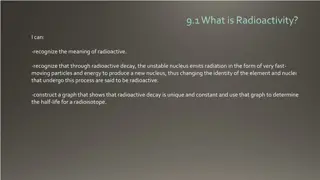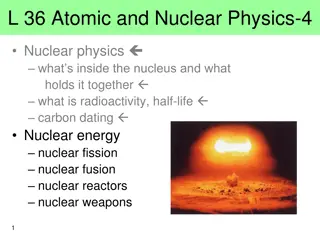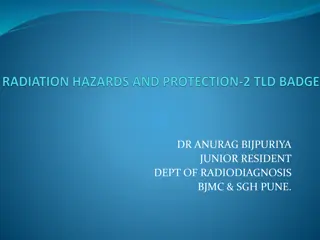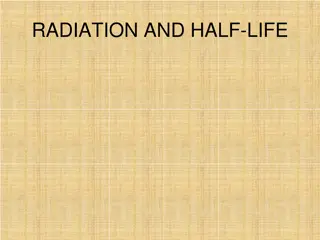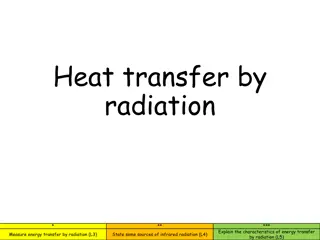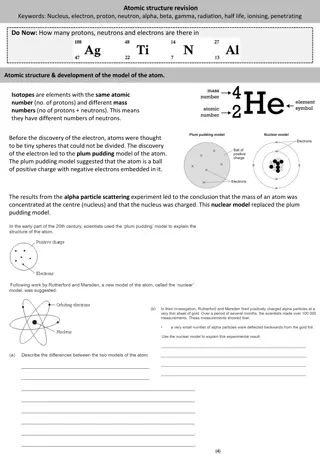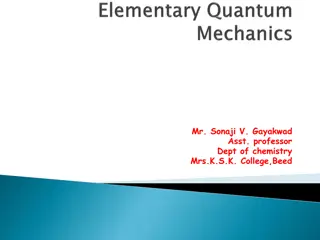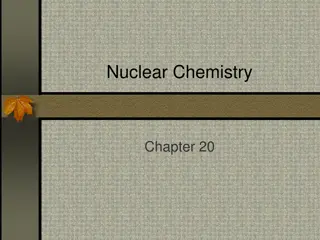Understanding Radiation and Radioactivity in Science
Radiation is energy in transit, while radioactivity is the emission of ionizing radiation by materials. This process involves ionization, which removes electrons from atoms, leading to various nuclear decay processes such as alpha decay, beta decay, gamma-ray emission, positron decay, electron capture, and X-ray production. Different types of radiation, including alpha, beta, gamma, and X-rays, interact with matter differently. Measures of radioactivity include the Curie, Becquerel, and different prefix units to quantify the amount of radioactive material present. This overview provides insights into the fundamental concepts of nuclear science.
Download Presentation

Please find below an Image/Link to download the presentation.
The content on the website is provided AS IS for your information and personal use only. It may not be sold, licensed, or shared on other websites without obtaining consent from the author. Download presentation by click this link. If you encounter any issues during the download, it is possible that the publisher has removed the file from their server.
E N D
Presentation Transcript
Radiation and Radioactivity Radiation: Energy in transit, either particulate or electromagnetic in nature Radioactivity: The characteristic of various materials to emit ionizing radiation Ionization: The removal of electrons from an atom. The essential characteristic of high energy radiations when interacting with
The Atom Protons 11p (1.007276 amu) Neutrons 10n (1.008665 amu) Electrons (0.0005486 amu) Neon-20 2010Ne (19.992434 amu)
Alpha Decay Daughter Nucleus Np-237 Th-234 Ra-228 Rn-222 ++ ++ Parent Nucleus Am-241 U-238 Th-232 Ra-226 Alpha Particle (Helium Nucleus) (4.00147 amu)
Beta (Negatron) Decay Daughter Nucleus Osmium-187 Calcium-40 Antineutrino Parent Nucleus Rhenium-187 Potassium-40 Beta Particle (electron)
Gamma-Ray Emission Gamma Ray Parent Nucleus Cesium-137 Molybdenum-99 Daughter Nucleus Barium-137m Technetium-99m
Positron Decay Neutrino Daughter Nucleus Boron-11 Carbon-13 + + + - Positron Particle (Positive electron) Parent Nucleus Carbon-11 Nitrogen-13 Annihilation Radiation
Electron Capture and Characteristic X-Rays Daughter Nucleus Iron-57 Neutrino Parent Atom Cobalt-57 Characteristic X-Ray
X-Ray Production (Bremsstrahlung) Electron X-Ray Target Nucleus Tungsten Anode (+) Cathode (-) X-Rays
Types of Radiation Paper Lead Plastic Concrete ++ ++ Alpha Beta Gamma and X-rays 10n Neutron
Measures of Radioactivity Activity: The quantity of radioactive material present at a given time: Curie (Ci) : 3.7x1010 disintegration per second (dps) milliCurie (mCi): 3.7x107 dps microCurie (mCi): 3.7x104 dps picoCuries (pCi): .037 dps Becquerel (Bq): 1 dps
Half-Life The time required for the amount of radioactive material to decrease by one-half 1200 1000 800 Activity 600 400 200 0 New 1 Half- Life 2 Half- Lives 3 Half- Lives 4 Half- Lives
Radiation Detection Gas Filled Detectors Voltage Source - + Incident Ionizing Radiation + + + + - Electrical Current Measuring Device - - - Anode + Cathode - Air or Other Gas
Radiation Detection Scintillation Detectors Incident Ionizing Radiation Light Photon Photomultiplier Tube Pulse Measuring Device - Sodium-Iodide Crystal Dynode Anode Photocathode Optical Window
Radiation and Radioactivity Radiation: Energy in transit, either as particles or electromagnetic waves Radioactivity: The characteristic of various materials to emit ionizing radiation Ionization: The removal of electrons from an atom. The essential characteristic of high energy radiations when interacting with matter.
Radiation Units Roentgen: A unit for measuring the amount of gamma or X rays in air Rad: A unit for measuring absorbed energy from radiation Rem: A unit for measuring biological damage from radiation
Elements An element is the smallest amount of a substance that still exhibits the properties of that substance. Elements are classified by the number of protons in each atom, and can be arranged in order in the Periodic Chart.
Atoms Atoms are the building blocks of all matter, made up of protons and neutrons and electrons. Almost all atoms are very stable, but some may have too much energy and be radioactive.
Molecules and Compounds Atoms group together or bond to each other forming molecules and compounds. Examples of these are water (2 hydrogen, 1 oxygen atoms) and sugar (6 carbon, 12 hydrogen and 6 oxygen atoms)
Three States of Matter Solid: Solids are items don't change their shapes like rocks, wood and ice. Liquid: Liquids flow, like water, alcohol and glass Gas: Gases are free flowing, like air, oxygen and steam. The difference between each is the amount of energy the molecules have
Electromagnetic Waves Electromagnetic waves are energy waves, ranging from the low energy radio waves to the high energy gamma rays. They have a height (amplitude) and a length between wave peaks (wave length)
Non-Ionizing Electromagnetic Radiation Non-Ionizing Electromagnetic Radiations do not have enough energy to remove electrons from atoms, such as: Ultraviolet Radiation Light Infrared Radiation Microwaves Radio Waves
Contamination vs Radiation Radiation and Contamination are often confused. Radiation is energy, while contamination is the physical presence of a radioactive material on something. So, you may have contamination on your shoe, but not radiation.
Ionizing Electromagnetic Radiation Ionizing Electromagnetic Radiations do have enough energy to remove electrons from atoms, such as: X-rays Gamma rays
Units of Contamination Contamination, or the presence of radioactive material on something is measured as count on a detector per some time like a minute (cpm), or by the actual decay rate (dps).
Radiation Effects and Risk Exposure: A measure of ionization in air from x-ray and gamma rays. Roentgens, or mR Dose: A measure of the energy absorbed in any material as a radiation passes through it. Rads or mrads, Gray or mGy. Dose equivalent: A measure of risk
Activities or Effects of Radiation Dose Food Irradiation: 100000 rads Cancer Radiation Therapy: 6000 rads Lethal WB Dose to 50% of Population: 350 rads Increase risk of cancer by 1% 12.5 rem Maximum Annual Occupational Dose: 5 rem
Radiation Known to Occur at High Doses Non-Stochastic Effects: A health effect where the severity of the effect increases with dose: Cataracts Sterility Loss of Hair (Epilation) Skin Reddening (Erythema) Acute Radiation Syndrome Death
Cancer and Cancer Risk Each year 1,000,000 cancers are diagnosed in the U.S. Cancer is the second leading cause of death in the U.S. Approximately 1 in 6 will die of cancer. Radiation exposure does not cause unique forms of cancer. The risk of cancer from radiation exposure is assumed to be linear with dose (ICRP 60)
Radiation and Risk Perceptions and Reality Public 1 2 3 4 5 6 7 8 9 Nuclear Power Motor Vehicles Handguns Smoking Motorcycles Alcoholic Beverages Private Aviation Police Work Pesticides Surgery Fire Fighting Large Construction Hunting Spray Cans Mountain Climbing 10 11 12 13 14 15
Radiation and Risk: Perceptions and Reality Public 16 17 18 19 20 21 22 23 24 25 26 27 28 29 30 Bicycles Commercial Aviation Electric Power Swimming Contraceptives Skiing X-Rays High School and College Football Railroads Food Preservatives Food Coloring Power Mowers Prescription Antibiotics Home Appliances Vaccinations
Radiation and Risk: Perceptions and Reality Public Experts 1 2 3 4 5 6 7 8 9 Nuclear Power Motor Vehicles Handguns Smoking Motorcycles Alcoholic Beverages Private Aviation Police Work Pesticides Surgery Fire Fighting Large Construction Hunting Spray Cans Mountain Climbing 20 1 4 2 6 3 12 17 8 5 18 13 23 26 29 10 11 12 13 14 15
Radiation and Risk: Perceptions and Reality Public Experts 16 17 18 19 20 21 22 23 24 25 26 27 28 29 30 Bicycles 15 16 9 10 11 30 7 27 19 14 21 28 24 22 25 Commercial Aviation Electric Power Swimming Contraceptives Skiing X-Rays High School and College Football Railroads Food Preservatives Food Coloring Power Mowers Prescription Antibiotics Home Appliances Vaccinations
Days of Life Lost from Various Risks Being an unmarried male Smoking cigarettes and male 3,500 2,250 2,100 1,600 1,300 980 900 850 800 700 520 300 207 141 130 95 95 95 Heart disease Being an unmarried female Being 30 percent overweight Cancer Being 20 percent overweight Having only an 8th grade education Smoking and being female Being poor Stroke Having a dangerous job Driving a car Pneumonia, Flu Alcohol Accidents in the home Suicide Diabetes
Days of Life Lost from Various Risks Being Murdered 90 74 41 40 39 37 30 27 18 17 13 8 6 6 5 5 2 0.02 Having an average risk job Drowning Having a job with radiation exposure Falls Walking down the street Having a safe job Fires and burns Using illegal drugs Poisoning Suffocation Natural Radiation Medical X-Rays Coffee Oral contraceptives Riding a bike Drinking Diet Sodas Radiation from Nuclear Industry
Activities which increase risk by 1 in a Million Smoking 1.4 Cigarettes Drinking 0.5 liter of wine Spending 1 hour in a coal mine Spending 3 hours in a coal mine Living two days in Boston or New York Traveling 10 miles by bicycle Traveling 150 miles by car Flying 1000 miles by jet Flying 6000 miles by jet Living two months in Denver Living two months in brick building Cancer, heart disease Cirrhosis of the liver Black lung disease Accident Air Pollution Accident Accident Accident Cancer caused by cosmic radiation Cancer caused by cosmic radiation Cancer caused by natural radiation Cancer caused by radiation Liver cancer caused by aflatoxin B Cancer caused by radiation One chest x-ray Eating 40 Tablespoons of peanut butter Living 5 years at site boundary of a nuclear plant Eating 100 charcoal -broiled steaks Living within 5 miles of a nuclear reactor for 50 years Cancer from benzopyrene Cancer caused by accidental radiation release
Fission Xenon-144 10n 10n 10n Neutron Uranium-235 Plutonium-239 Strontium-90
Fission Chain Reactions 10n Neutron Uranium-235 Plutonium-239
Pressurized Water Reactor Control Rods Turbine Generator Steam Generator Reactor Vessel Pump Condensor Cooling Water Pump Core Primary Containment Pump
Boiling Water Reactor Turbine Generator Reactor Vessel Pump Core Condensor Cooling Water Jet Pump Pump Control Rods Pump Primary Containment
Barriers Against Release of Radiation Steel Containment Fuel Pellets Concrete Shield Building Fuel Rods Core Steel Pressure Vessel
A crayon* (without the tip) is about the size of five uranium fuel pellets stacked together Source Energy Equivalents 15 Barrels of oil Five uranium fuel pellets .. 12 1/2 Tons of wood have as much energy available in todays nuclear power plants as... 5 Tons of coal 85,000 cu ft of natural gas * Crayons are not radioactive nor are they used as nuclear fuel
IONIZING RADIATION School Presentation
What Will You Learn Today? Identify natural background and manufactured sources of radiation. Learn how radiation affects living things. Learn how radiation is detected using radiation survey meters
The three basic particles of the atom are PROTONS, NEUTRONS AND ELECTRONS electron proton neutron There are stable and unstable atoms
UNSTABLE atoms emit energy RF wave infrared visible uv x-ray -ray cosmic low energy low energy high energy high energy ionizing radiation ionizing radiation non-ionizing non-ionizing
Non-Ionizing Radiation Does not have enough energy to remove electrons from surrounding atoms
Ionizing Radiation - can deposit energy in neighboring atoms resulting in the removal of electrons.
Alpha Radiation is only a hazard when inside your body (internal hazard) Your skin will stop it can t penetrate skin internal hazard stopped by paper found in soil, radon and other radioactive materials



